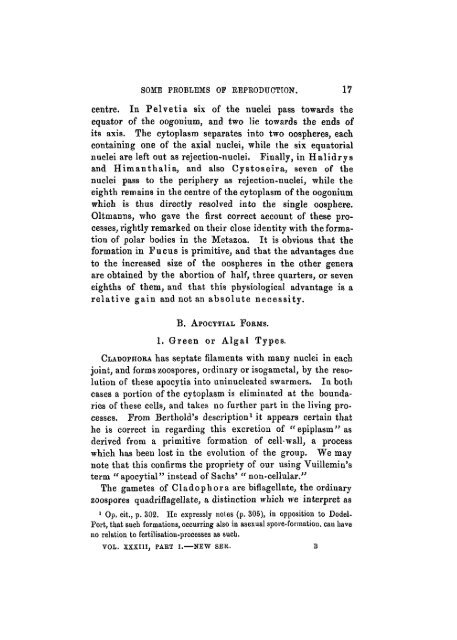Some Problems of Reproduction: a Comparative Study of ...
Some Problems of Reproduction: a Comparative Study of ...
Some Problems of Reproduction: a Comparative Study of ...
You also want an ePaper? Increase the reach of your titles
YUMPU automatically turns print PDFs into web optimized ePapers that Google loves.
SOME PROBLEMS OF BEPBODUCTTON. 17<br />
centre. In Pelvetia six <strong>of</strong> the nuclei pass towards the<br />
equator <strong>of</strong> the oogonium, and two lie towards the ends <strong>of</strong><br />
its axis. The cytoplasm separates into two oospheres, each<br />
containing one <strong>of</strong> the axial nuclei, while the six equatorial<br />
nuclei are left out as rejection-nuclei. Finally, in Halidrys<br />
and Himanthalia, and also Cystoseira, seven <strong>of</strong> the<br />
nuclei pass to the periphery as rejection-nuclei, while the<br />
eighth remains in the centre <strong>of</strong> the cytoplasm <strong>of</strong> the oogonium<br />
which is thus directly resolved into the single oosphere.<br />
Oltmanns, who gave the first correct account <strong>of</strong> these processes,<br />
rightly remarked on their close identity with the formation<br />
<strong>of</strong> polar bodies in the Metazoa. It is obvious that the<br />
formation in Fucus is primitive, and that the advantages due<br />
to the increased size <strong>of</strong> the oospheres in the other genera<br />
are obtained by the abortion <strong>of</strong> half, three quarters, or seven<br />
eighths <strong>of</strong> them, and that this physiological advantage is a<br />
relative gain and not an absolute necessity.<br />
B. APOCYTIAL FORMS.<br />
1. Green or Algal Types.<br />
CLADOPHORA has septate filaments with many nuclei in each<br />
joint, and forms zoospores, ordinary or isogametal, by the resolution<br />
<strong>of</strong> these apocytia into uninucleated swarmers. In both<br />
cases a portion <strong>of</strong> the cytoplasm is eliminated at the boundaries<br />
<strong>of</strong> these cells, and takes no further part in the living processes.<br />
From Berthold's description 1 it appears certain that<br />
he is correct in regarding this excretion <strong>of</strong> " epiplasm" as<br />
derived from a primitive formation <strong>of</strong> cell-wall, a process<br />
which has been lost in the evolution <strong>of</strong> the group. We may<br />
note that this confirms the propriety <strong>of</strong> our using Vuillemin's<br />
term "apocytial" instead <strong>of</strong> Sachs' "non-cellular."<br />
The gametes <strong>of</strong> Cladophora are biflagellate, the ordinary<br />
zoospores quadriflagellate, a distinction which we interpret as<br />
1<br />
Op, cit., p. 302. He expressly notes (p. 305), in opposition to Dodel-<br />
Port, that such formations, occurring also in asexual spore-formation, can have<br />
no relation to fertilisation-processes as such.<br />
VOL. XXXIII, PAET I.—NEW SER. B

















